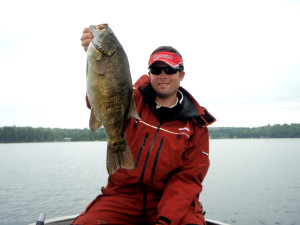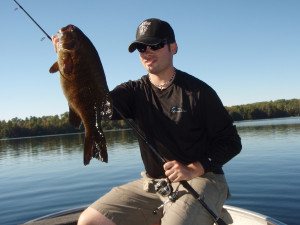The Northwoods Smallmouth Calendar
By Andrew Ragas
As the new season approaches, anglers are planning their trips and getaways for the upcoming year. With the Northwoods of Wisconsin serving as my home waters, I have been asked to offer an annual fishing calendar: To help traveling and adventurous anglers plan their fishing trips and vacations efficiently and more effectively.
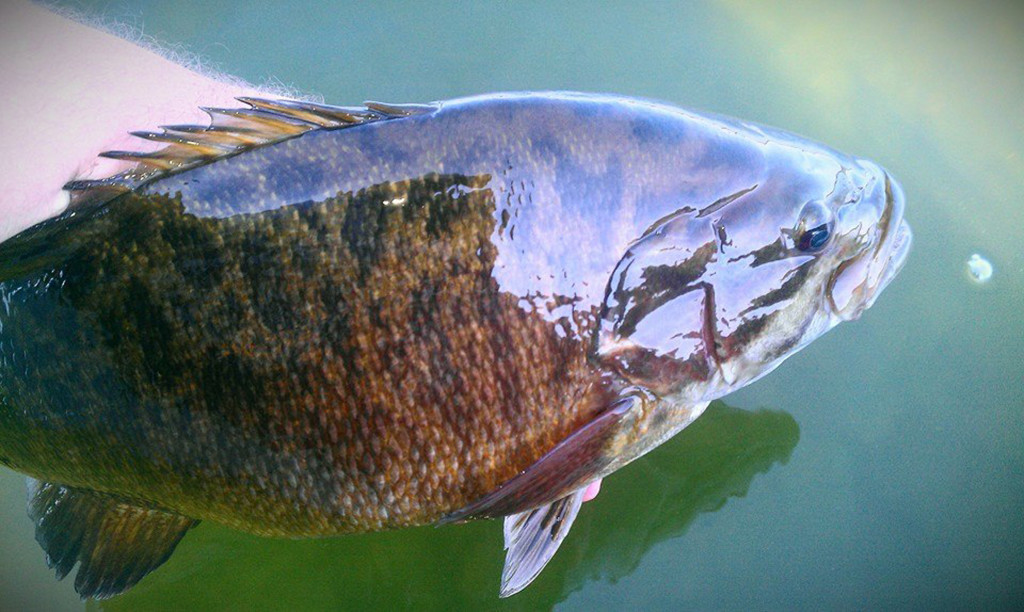
When and Where
Opening day for Wisconsin fishing is traditionally the first Saturday in May. Fishing for almost all major fish species on many Wisconsin waters begins on that day with the season normally lasting through mid November on an average climate year. Opportunities abound, and as a part-time Wisconsin resident from May through October I’m lucky to have the luxury of patterning many statewide fisheries, and gaining the knowledge for where to go in the northern tier of the state.
According to geographic experts, the dividing line for entry into Northern Wisconsin is recognized along state HWY 29, which travels horizontally from Hudson to Green Bay. However, my Northwoods map officially begins several miles further north, with the official gateway located in the Wisconsin River paper mill town of Merrill. Here, the landscape noticeably changes from fertile farmland to clean pine forest. The entire northern region of the state and its never-ending fishing destinations runs northward to Lake Superior and the ‘Yooper’ border, and then stretches from Green Bay in the east, to the Saint Croix River and its formation of the Wisconsin/Minnesota border in the west.
Within this region are several popular fishing towns and destinations. Popular areas are the Great Lakes towns of Ashland and Bayfield on Lake Superior, which offers world class trout and salmon fishing, as well as walleye and an expanding smallmouth bass fishery. Then to the east along Lake Michigan is the Bay of Green Bay, encompassing the towns of Octonto, Green Bay, and Sturgeon Bay. This region of the bay and Door County contains some of the best walleye, muskie, and smallmouth bass fishing in the entire planet.
Moving inland, the fishing gets more challenging, but is still worth everyone’s time. In Northwest Wisconsin, the region of Hayward, Spooner, and Minong is revered for its historic fishing and musky lore. Then where I live and spend most of my time at is the Minocqua/ Woodruff Lakeland area of Iron, Vilas and Oneida Counties. This region encompasses almost 4,000 lakes and offers some of the best diversity of lake types and inland fishing that can be experienced in all of Wisconsin. For the sake of space and word count, there are several more areas and honey-holes located in between, that should never be dismissed by anyone.
With a lot of land to scope through, and available waters to fish, we’ll cover smallmouth bass in this edition. I will also recommend some of the major bodies of water I have fished, or know of well, and some new destinations I have plans to fish at some point in 2015.
Spring Fishing
The spring season takes place during the months of May and June, and offers some of the best fishing of the year for all species. Encompassing the pre-spawn to early summer period, all species of fish are on the feed, and in abundance throughout the shallows of most lakes and river systems.
As most know, the largest specimens of smallmouth bass are my primary species of interest throughout the year. With exception to a few distinct summer and fall periods, spring fishing is simply the best. There is a reason why I skip out on social events during Mother’s Day, Memorial Day weekend, and other weekends. It’s because the smallmouth fishing in Wisconsin is that incredibly awesome and nobody realizes it! Thankfully family and friends understand.
A popular destination is undoubtedly Sturgeon Bay and its surrounding waters, where no other place in the world contains as many 4 and 5 pound fish. Every spring, wolf packs of anglers visit for weekend tournaments and the popular Sturgeon Bay Open. In the last two opens, fish up to 8.5 lbs. have been caught and released. Meanwhile, other anglers schedule week-long spring vacations at one of the many lakeside resorts and hotels, or hire any number of the guides including Dale Strochein and Brett Alexander to learn the big lake better or to have the opportunity to catch a big fish.
While Sturgeon Bay is a spoiler that, for better or for worse, changes bass fishermen’s lives and has the potential of now breaking the smallmouth world record, I will always prefer fishing the more challenging and diverse inland fisheries simply because I grew up fishing on them, and they all have a special place in my heart.
In recent years, I’ve caught and handled hundreds of trophy smallmouth bass exceeding lengths of 18 inches and weights surpassing 4 pounds. With my largest smallmouth to date at 22 inches length, weighing in at around 7 lbs., I am convinced that my inland waters, rich in crayfish and pelagic baitfish, are capable of rearing the next Wisconsin state record all thanks to conservation and superb lake management. In Vilas and Oneida County alone, I have the joy of having over 200 quality trophy lakes within 40 miles of Minocqua. My region is now becoming known as a world class bass fishing destination due to the increase in tournaments, and number of out of state license plates I’m now observing at the boat landings. Because each lake fishes differently, and contains different population densities and size structures, I love having the option to fish multiple lakes per day, and cater my daily outings to my personal needs as well as specific angling styles & techniques. Few places in the world outside of southern Ontario and Minnesota have this much bass fishing diversity within such a large concentration. If seeking a guide, please consult with me.

Other inland waters worthy of smallmouth trips are the massive lake chains, Eagle River and Three Lakes, Minocqua Chain (for numbers), Lac du Flambeau chain, and the individual lakes around Hayward that includes Round, Grindstone, and Lac Courte Orielles…… and don’t forget to lake hop and jump throughout the many other smaller lakes in these regions too, as many of them contain some of the largest fish you will ever catch!
The river systems and its flowages are home to some of the most under fished, fastest growing and fattest smallmouth populations in the state. These waters include the upper Wisconsin River system where my friend Kurt Schultz offers jet boat trips in spring before musky season opens, the Menominee River outside of Florence where Mike Mladenik is revered, the remote Saint Croix River from Saint Croix Falls to Danbury, and the Turtle-Flambeau Flowage where I spend considerable amount of time dissecting thru its stump fields and channels annually.
Summer Fishing
Summer in the northwoods is a season of capitalizing on feeding windows and lake selection. Water temperatures will hit their annual peak in the upper 70 degree range, and the season lasts from June through early September.
Summertime fishing for smallmouths is a challenging game and half the battle is being able to locate them. What I look for during the summer months are lakes with colder, cooler, clearer, deeper water packed with a lot of structure and contours.
Of the popular Great Lakes destinations, two venues come to mind. Chequamegon Bay of Lake Superior in Ashland, and Sturgeon Bay off Door County are guaranteed bets and will remain outstanding for fishing through early November. Up north, picturesque cliffs and rock walls surround some of the nearby Apostle Islands, where submerged rock reefs rise from the cold depths of Lake Superior and sand dunes and submerged wood straddle the southern shores. Chequamegon Bay is trophy regulated water whose fishing seems to get better as the year progresses, according to its known guides Chris Beeksma and Josh Tiegen. Meanwhile back to Sturgeon Bay, where its population is more abundant, the best summertime fishing takes place in June through early July, as shallow fishing runs hot before fish move out deeper in summer to roam and suspend, and stay there through fall.
On the inland waters, the cold deep lakes with good smallmouth fishing are easy to identify. Good identifiers are high maximum depth, heavy presence of baitfish species (ciscoes and smelt), and potential for a two-story fishery capable of rearing cold water species and that doesn’t become too affected by heat. Ideal destinations possessing most of these characteristics are scattered throughout the north. The best mid-summer smallmouth waters by me in Vilas and Oneida county with good average fish size (2 to 3 lbs.) and a higher population density is the Lac Du Flambeau chain and Manitowish Chain, and individual lakes that include Trout, Presque Isle, North Twin, Anvil, Butternut, and Kentuck. Additional lakes worth a visit are Metonga and Pelican located in southern Oneida County. And out west near Hayward, Round, Grindstone and Lac Courte Oreilles are outstanding major fisheries. There’s more too, but I’ll let you find them yourself.
For anglers with smaller boats and even kayak, there are few destinations as good as the Flambeau River in Sawyer and Rusk County, and St Croix River along the Minnesota border through the State Park and National Scenic Waterway. Smallmouth bass in these remote sections of the Flambeau and St. Croix grow big and beefy, and lurk in the free-flowing narrow, fast-moving sections of river. Successful fishing in the narrow sections means finding deeper holes and places where swift current meets slack water. Similar quality fishing experiences can be had on the upper Wisconsin River from Eagle River through Rhinelander, and all the way downstream to Merrill where mid-stream boulders, swift rapids, and rugged terrain dominate the river landscape offering smallmouths perfect habitat and cold water sanctuaries during mid-summer heat. River fishing in these wilderness settings is often a productive, memorable adventure.
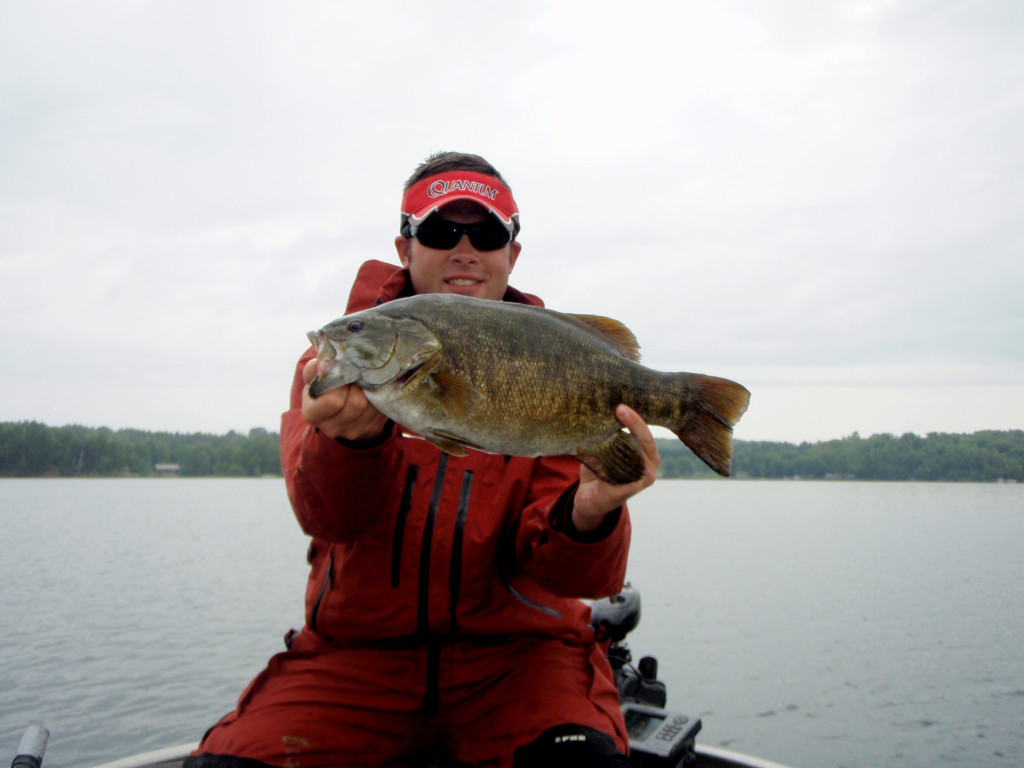
Fall Fishing
Autumn in the northwoods is about location rather than presentation. Because when you locate the right spots, chances are most fish will be concentrated in them, and on the binge in preparation for the winter months. Additionally, it doesn’t get any better than being immersed within the beauty of bright color from fall foliage, and up north it is EVERYWHERE.
The fall season for me officially begins following Labor Day, in mid-September when water temperatures begin to cool down from the 70’s into the low 60 degree range. The plunge continues through November before ice begins to form, resulting in the open water season to end. My fall season is usually spent smallmouth fishing throughout September into the first two weeks of October.
What I’ve learned is that autumn is not a single season, but encompasses three sub-seasons: Early fall which offers fast action, the mid-Indian summer phase, and cold water stage that often kicks out the largest fish. In the northwoods, the fall period takes place from mid September through early November when their overwintering period begins.
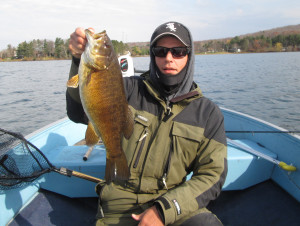
Johnny Amato with one of several 4-plus pounders he caught in October 2014, in Forest County Wisconsin.
Diminishing daylight and falling water temperatures trigger smallmouths to binge feed in order to survive through the winter months. With their active feeding, most would think the fishing would be spectacular, but it’s not usually the case. Fall fishing for smallmouths often requires much searching and good usage of electronics. Along with schools of pelagic baitfish species and yellow perch, smallmouths move out deep to main lake areas and begin concentrating in close proximity to their wintering holes, usually along steep ledges and deep structure. When you can locate their food, you will often locate the fish.
A lot of northwoods lakes, including Lake Superior’s Chequamegon Bay, are set up perfectly for good fall fishing where the bite can last through early November. Choosing the proper lake is important. In my opinion, clear water lakes with limited structure and a restricted forage base is the key. Many deep clear water lakes are home to giant smallmouth and are rarely ever fished for them.
Don’t make the mistake of only fishing big lakes. But if you must, some of the better fall options are near me in Vilas County and includes the Lac Du Flambeau Chain, Trout, Big Muskellunge, Star, Black Oak, Presque Isle, North Twin, Long and Big Sand, and Butternut. Small clear water lakes can hold populations of large smallmouths too, and are my most preferred destinations at this time of season. Each year I catch and release a number of 20 inch fish from smaller lakes of only 100 to 400 acres in size. I safeguard my biggest secrets so I won’t disclose these honey holes for a number of reasons. It is important to find a lake with a limited fishery dominated by smallmouths; if a healthy smallmouth population exists, they can be the dominant predator in the lake. Lakes with fewer walleyes are the best also. These smaller lakes are easier to fish with smallmouth schooling up and concentrated usually in one or two major areas of the lake, and don’t require the most strenuous searching to locate.

Make Your Plans in 2015
Looking for a quality destination to wet a line in Northern Wisconsin? Hopefully you’ve read the right story here. Whether interested in a lake or river in a specific region or a nearby town you’ll be visiting, Wisconsin’s Northwoods offers a variety of smallmouth bass fishing opportunities for traveling anglers and visitors alike. I can obviously still write about more, but I think I’ve covered enough destinations and possible trips to keep everyone else occupied and entertained for fun.













